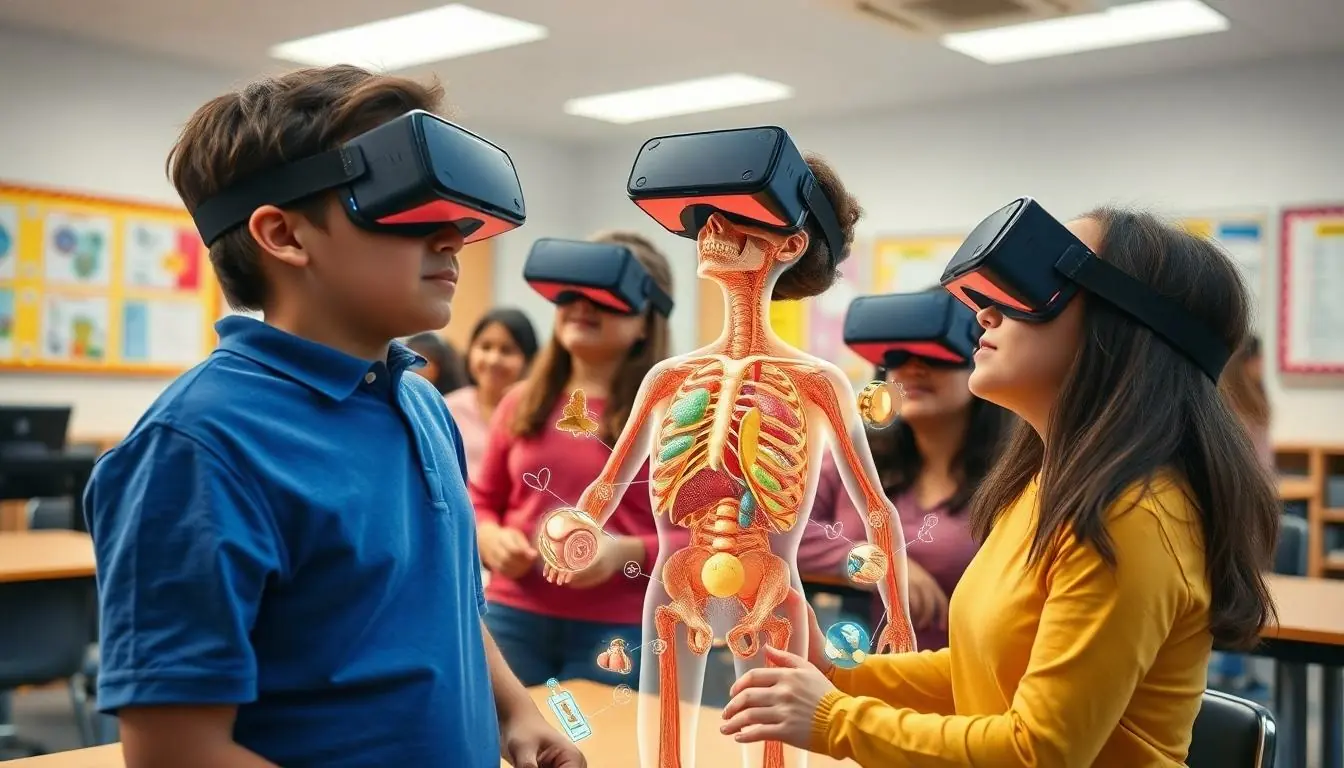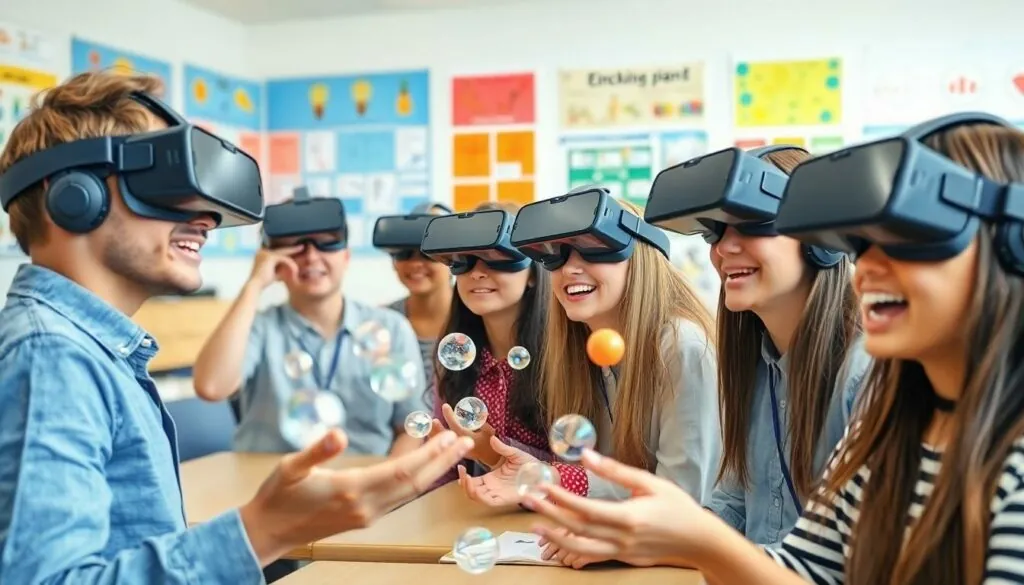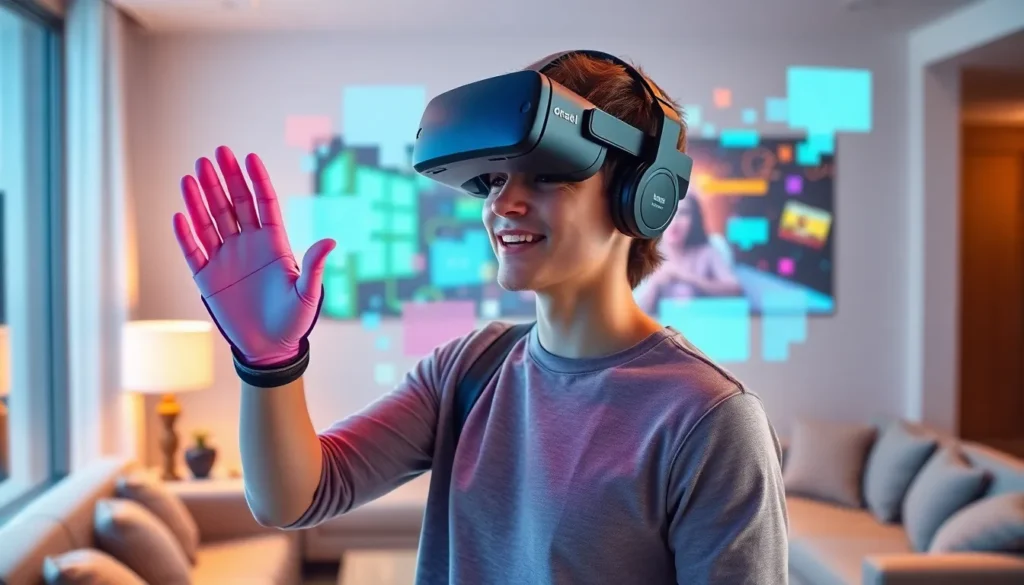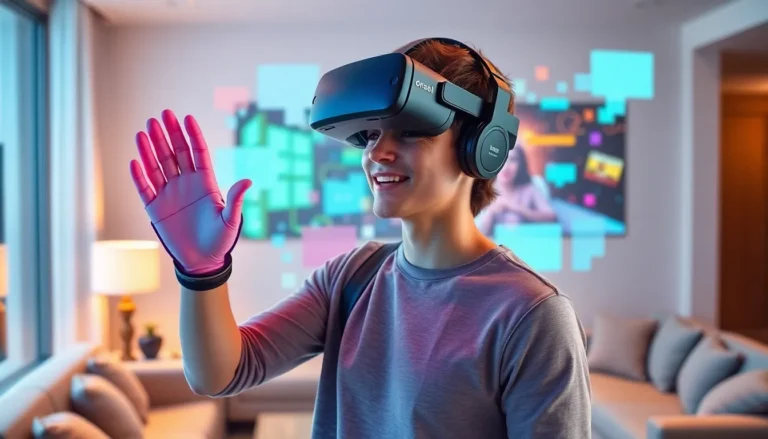Table of Contents
ToggleImagine stepping into a classroom where textbooks come to life and history lessons unfold right before your eyes. With VR technology for education, that dream is becoming a reality. Gone are the days of boring lectures and static images; students can now explore ancient civilizations or dive into the human body as if they were on a field trip—without ever leaving their seats.
Overview of VR Technology for Education
VR technology fundamentally changes the educational landscape. It provides immersive experiences that enhance student engagement. Students interact with subjects in a virtual environment, which often leads to better retention of information. Lessons transition from traditional formats to dynamic simulations that bring learning to life.
Specifically, fields like history become more tangible. Learners can explore ancient civilizations through virtual tours, making distant pasts more relatable. STEM subjects also benefit significantly. Students examine complex biological systems or conduct experiments that might otherwise be too dangerous or expensive in a typical classroom setting.
The advantages extend beyond content delivery. Collaboration among students increases when using VR tools. Group projects become more engaging as learners participate in shared virtual spaces. Technology fosters creative thinking and problem-solving skills as students navigate challenges presented in their simulations.
Educators find VR appealing too. It allows for personalized learning experiences tailored to individual student needs. Real-time feedback emerges based on students’ interactions within VR environments, enabling teachers to adjust their teaching strategies accordingly.
Implementation of VR in education isn’t without challenges. Costs related to equipment and content creation can be significant. However, the potential benefits often outweigh the initial investments. As VR technology advances, accessibility increases, making it easier for institutions to incorporate it into their curricula.
Research consistently shows that immersive learning experiences yield positive outcomes. This evidence supports a growing movement towards adopting VR in educational settings. The future of education may very well hinge on embracing this innovative technology.
Benefits of VR Technology in Learning

VR technology in education provides several advantages that promote effective learning outcomes. Engaging students more deeply in their studies becomes possible through immersive experiences.
Enhanced Engagement and Motivation
Incorporating VR in the classroom results in heightened interest in subjects. Students actively participate in virtual experiences that transport them beyond traditional learning methods. For example, they can tour historical sites or explore the human body in 3D. Such interactive environments foster excitement and curiosity. Collaboration occurs naturally in these settings, as students work together on projects, enhancing the overall classroom dynamic.
Improved Retention of Information
Retention rates increase significantly with the use of VR technology. Experiential learning methods, like engaging in simulations, allow students to remember information more effectively. Studies indicate that learners retain up to 75% of knowledge when they actively participate compared to 10% with passive learning methods. Real-life scenarios reinforce understanding and make complex concepts easier to grasp. Students often recall their virtual experiences long after the lessons conclude, resulting in a deeper knowledge base.
Applications of VR Technology in Education
VR technology has various applications that significantly enhance the educational experience. Two prominent areas include virtual field trips and simulations for practical training.
Virtual Field Trips
Students embark on virtual field trips that allow them to explore historical sites and natural wonders worldwide. Educators use these immersive experiences to teach geography and history. Engaging with ancient ruins or exploring the ocean floor enhances understanding. Increased participation leads to higher retention rates, supporting studies showing learners retain up to 75% of information through active exploration. Consequently, students experience the world beyond their classroom walls, creating rich learning moments that textbooks alone can’t provide. Teachers benefit by having robust tools to convey complex topics.
Simulations and Practical Training
Simulations offer students hands-on practice in a safe environment. Science classes utilize VR for conducting experiments that would otherwise pose risks or be costly. Medical students practice surgical techniques in virtual settings, gaining crucial skills before working with patients. Additionally, engineering programs simulate real-world challenges, allowing learners to troubleshoot and innovate. In vocational training, learners gain experience relevant to their future careers. Such practical training reinforces knowledge retention, providing a significant advantage over traditional learning methods. Overall, VR simulations create opportunities for mastering skills in various fields.
Challenges of Implementing VR Technology
Implementing virtual reality technology in education presents several challenges that educators must navigate.
Cost and Accessibility Issues
Costs associated with VR equipment and content creation can deter institutions from adopting this technology. Schools often face budget constraints that limit access to high-quality VR headsets and software. Educational institutions in low-income areas struggle even more, as funds for technology may be lacking. Additionally, maintenance and updates for VR systems incur ongoing costs, complicating long-term investment plans. While some grants support VR initiatives, they aren’t universally available. Students also need access to appropriate environments where VR can be used safely and effectively, impacting overall engagement.
Technical Limitations
Technical limitations of VR technology can hinder its effectiveness in classroom settings. Compatibility issues arise when VR systems require specific hardware and software configurations. Additionally, many educators lack adequate training to implement VR in their lessons, resulting in underutilization of resources. Furthermore, the immersive experiences provided by VR can induce motion sickness or discomfort, affecting some users. Students with disabilities may encounter accessibility barriers in VR experiences, limiting inclusivity. Effective integration requires ongoing tech support and updates, further complicating deployment efforts in schools.
Future Trends in VR Technology for Education
VR technology continues to evolve, promising to reshape educational experiences further. Innovations in both hardware and software drive enhancements that make virtual learning more accessible and effective.
Advances in VR Hardware and Software
Quality and affordability improve as VR hardware advancements take place. Compact devices now allow for mobility, creating opportunities for learning anywhere. Software developments also support interactive and customizable environments, catering to diverse educational needs. With powerful graphics and real-time simulations, students can dive deep into complex topics. As devices become user-friendly, even those without technical expertise can navigate VR platforms easily. Classroom integration becomes seamless, fostering broader adoption among educators.
Integration with Other Educational Technologies
Collaboration between VR and other technologies amplifies educational impact. Learning Management Systems (LMS) now incorporate VR modules, allowing for rich content delivery alongside traditional resources. Emerging artificial intelligence tools offer personalized recommendations within VR environments, responding to students’ individual learning styles and paces. Gamification elements in VR applications increase student motivation and engagement. Virtual and augmented reality experiences pair well with these technologies, creating a more immersive and enjoyable learning atmosphere. As educators embrace this integration, they can create multifaceted learning experiences that enhance understanding and retention.
The integration of VR technology in education is revolutionizing how students learn and engage with various subjects. By providing immersive experiences that foster curiosity and collaboration, VR enhances retention and understanding in ways traditional methods cannot match. As technology continues to advance, the potential for personalized and interactive learning experiences will only grow.
While challenges like cost and accessibility remain, the long-term benefits of VR in education present a compelling case for its adoption. Educators are poised to harness these advancements to create dynamic learning environments that inspire and motivate students. Embracing VR technology can lead to a brighter future for educational practices, making learning more engaging and effective.







